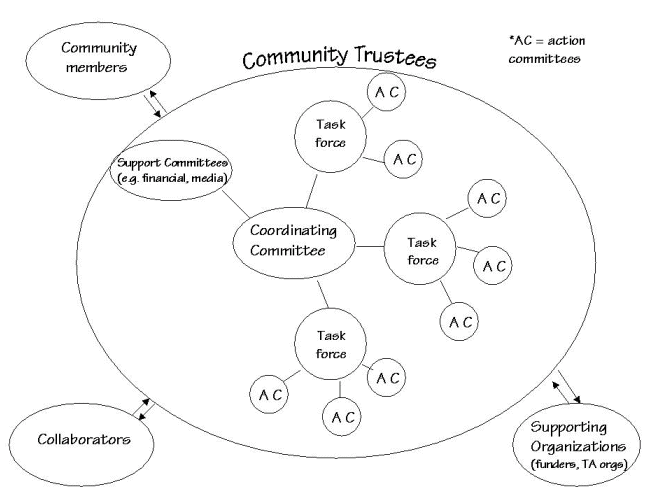| Learn how to develop a framework that gives members clear guidelines on building organizational structure, and keeping the organization functional. |
-
What is organizational structure?
-
Why should you develop a structure for your organization?
-
When should you develop a structure for your organization?

What is organizational structure?
By structure, we mean the framework around which the group is organized, the underpinnings which keep the coalition functioning. It's the operating manual that tells members how the organization is put together and how it works. More specifically, structure describes how members are accepted, how leadership is chosen, and how decisions are made.
Why should you develop a structure for your organization?
- Structure gives members clear guidelines for how to proceed. A clearly-established structure gives the group a means to maintain order and resolve disagreements.
- Structure binds members together. It gives meaning and identity to the people who join the group, as well as to the group itself.
- Structure in any organization is inevitable -- an organization, by definition, implies a structure. Your group is going to have some structure whether it chooses to or not. It might as well be the structure which best matches up with what kind of organization you have, what kind of people are in it, and what you see yourself doing.
When should you develop a structure for your organization?
It is important to deal with structure early in the organization's development. Structural development can occur in proportion to other work the organization is doing, so that it does not crowd out that work. And it can occur in parallel with, at the same time as, your organization's growing accomplishments, so they take place in tandem, side by side. This means that you should think about structure from the beginning of your organization's life. As your group grows and changes, so should your thinking on the group's structure.
Elements of Structure
While the need for structure is clear, the best structure for a particular coalition is harder to determine. The best structure for any organization will depend upon who its members are, what the setting is, and how far the organization has come in its development.
Regardless of what type of structure your organization decides upon, three elements will always be there. They are inherent in the very idea of an organizational structure.
They are:
- Some kind of governance
- Rules by which the organization operates
- A distribution of work
Governance
The first element of structure is governance - some person or group has to make the decisions within the organization.
Rules by which the organization operates
Another important part of structure is having rules by which the organization operates. Many of these rules may be explicitly stated, while others may be implicit and unstated, though not necessarily any less powerful.
Distribution of work
Inherent in any organizational structure also is a distribution of work. The distribution can be formal or informal, temporary or enduring, but every organization will have some type of division of labor.
There are four tasks that are key to any group:
- Envisioning desired changes. The group needs someone who looks at the world in a slightly different way and believes he or she can make others look at things from the same point of view.
- Transforming the community. The group needs people who will go out and do the work that has been envisioned.
- Planning for integration. Someone needs to take the vision and figure out how to accomplish it by breaking it up into strategies and goals.
- Supporting the efforts of those working to promote change. The group needs support from the community to raise money for the organization, champion the initiative in the state legislature, and ensure that they continue working towards their vision.
Common Roles
Every group is different, and so each will have slightly different terms for the roles individuals play in their organization, but below are some common terms, along with definitions and their typical functions.
- An initial steering committee is the group of people who get things started. Often, this group will create plans for funding, and organizational and board development. It may also generate by-laws, and then dissolve. If they continue to meet after approximately the first six months, we might say they have metamorphosed into a coordinating council.
- A coordinating council (also referred to as a coordinating committee, executive committee, and executive council), modifies broad, organization-wide objectives and strategies in response to input from individuals or committees.
- Often, one person will take the place of the coordinating council, or may serve as its head. Such a person may be known as the Executive Director, Project Coordinator, Program Director, or President. He or she sometimes has a paid position, and may coordinate, manage, inspire, supervise, and support the work of other members of the organization.
- Task forces are made up of members who work together around broad objectives. Task forces integrate the ideas set forward with the community work being done.
For example, from the director of a coalition to reduce violence in a medium-sized city: "Currently, we have three operational task forces. Members of each have an ongoing dialogue with members of the coordinating council, and also with their action committees. The oldest was formed with the goal of eliminating domestic violence about fifteen years ago, when a local woman was killed by her husband. Then, after several outbreaks of violence in the schools a few years back, our group offered to help, and a second task force sprung up around reducing youth violence. We've just started a third, with the goal of increasing gun safety.
"All of it is interrelated, and all of it applies to our mission of increasing the safety of residents of South Haven, as well as that of our visitors. But each task force is contributing to that mission in vastly different ways, with different objectives, and using different strategies. 'Cause, you know, the strategies you use to stop a ninth grader from bringing a gun to school just aren't the same as the ones you use to stop a 40-year-old man on unemployment from beating his wife."
- Action committees bring about specific changes in programs, policies, and practices in the sectors in which they work.
For example, the task force on domestic violence mentioned above has the following action committees:
- A government and law enforcement committee. Members include police officers, lawyers, a judge, and a state representative. Currently, they are trying to pass laws with stronger penalties for those convicted of domestic violence, especially repeat offenders. They are also training officers to be better able to spot an abusive relationship, and better able to inform a victim of his or her options.
- A social services committee. Members (who include representatives from most of the service agencies in town) work to assure that staff members know where to send someone for the resources he or she needs. They are also trying to increase the number of trained volunteer counselors who work at the battered women's shelter.
- A media committee. Members include local journalists, writers, and graphic designers. They keep the project and the issue in the public's minds as much as possible with editorials, articles and news clips of events, as well as advertisements and public service announcements.
- Support committees are groups that help ensure that action committees or other individuals will have the resources and opportunities necessary to realize their vision. Financial and media committees are examples of committees formed to help support or facilitate your work.
- Community trustees, also known as the board of trustees or as the board of directors, provide overall support, advice, and resources to members of the action groups. They are often either people who are directly affected by the issue or have stature in the community. That way, they are able to make contacts, network with other community leaders, and generally remove or weaken barriers to meeting organizational objectives.
- Grantmakers are another part of the picture. Grantmakers exist on an international, national, state, and local level and may be private companies and foundations, or local, county, state, or federal government organizations (for example, block grants given by the city would fall into this category).
- Support organizations (not to be confused with the support committees listed above) are groups that can give your organization the technical assistance it needs.
- Partner organizations are other groups working on some of the same issues as your organization.
Although this list is pretty extensive, your organization may only use two or three of the above mentioned roles, especially at the beginning. It's not uncommon for a group to start with a steering committee, ask others to serve as board members, and then recruit volunteers who will serve as members of action committees. In this broad spectrum of possibilities, consider: Where does your organization fit in? Where do you want to be?
Examples of Structure
So how can all of these pieces be put together? Again, the form a community group takes should be based on what it does, and not the other way around. The structures given are simply meant to serve as examples that have been found to be effective for some community-based organizations; they can and should be adapted and modified for your own group's purposes.
A relatively complex structure
Example - The Ste. Genevieve's Children's Coalition
The Ste. Genevieve's Children's Coalition is a relatively large community-based group. They have a coordinating council, a media committee, and three task forces, dealing with adolescent pregnancy, immunization, and child hunger. Each of the task forces has action committees as well. For example, the adolescent pregnancy reduction task force has a schools committee that focuses on keeping teen parents in school and modifying the human sexuality curriculum. A health organizations committee focuses on increasing access and use of the youth clinic. The media committee works to keep children's issues in the news, and includes professionals from the local television stations, radio stations, newspaper, and a marketing professional. The coordinating council is composed of the executive director, her assistant, the media committee chair, and the chairs of each of the three task forces. A board of directors has been invaluable in helping keep the coalition financially viable.
In diagram form, a complex organization might look like this:

And in diagram form:

As smaller size means fewer people, these groups are usually less complex, as they have less need for a formal hierarchy and instead have governance that is consensus-based. A diagram of such a small group might look something like this, with each of the circles representing an individual member:

What type of structure should you choose?
First, decide upon the formality your organization will have. The following table, adapted from The Spirit of Coalition Building can help you make this first decision.
| Conditions favoring more or less formality in organizational structures | ||
| Condition | A looser, less formal, less rule bound structure would be favored when... | A tighter, more formal, more rule-bound structure would be favored when... |
| Stage of organization development | The organization is just starting | The organization is in later stages of development |
| Prior relationships among members | Many such relationships already exist | Few such relationships already exist |
| Prior member experience in working together | Many such experiences have occurred | Few such experiences have occurred |
| Member motivation to be part of the organization | Motivation is high | Motivation is low |
| Number of organization tasks or issues (broadness of purpose) | There is a single task or issue | There are multiple tasks or issues |
| Organization size | The organization is small | The organization is large |
| Organization leadership | The leadership is experienced | The leadership is inexperienced |
| Urgency for action | There is no particular urgency to take action now | There is strong urgency to take action now |
Organizational structure is something that is best decided upon internally, through a process of critical thinking and discussion by members of the group.
In your discussions, your answers to the following list of questions may guide your decisions.
- What is your common purpose? How broad is it? Groups with broader purposes often have more complicated structures, complete with many layers and parts, than do groups with more narrow purposes.
- Is your group advocacy oriented or service oriented? Service organizations use "top down," one-person-in-charge structure much more often than do advocacy based groups.
- Is your organization more centralized (e.g., through the work of a specific agency ) or decentralized (e.g., different neighborhoods working independently on the same problem)? A decentralized group might find a "top-down" structure inappropriate, as such a group often has several peers working together on an issue.
- How large is your organization? How large do you envision it becoming? A very small organization may wish to remain relatively informal, while a community-wide group might require a more formal structure. A related question, with similar consequences, is:
- How large is the community in which you work?
- How old is your organization? How long do you envision it lasting? A group formed to resolve a single issue might not need a formal structure at all, while an organization with long-term goals may want something more concrete, with clearer divisional responsibilities and authority.
- Is the organization entirely volunteer, or are there (or will there be) paid staff? How many? An organization with many paid staff members may find it more necessary to have people "in charge," as there are generally more rules and responsibilities for paid staff members, and thus, there must be more supervision in carrying out these roles.
- Should yours be a new organization, or part of an existing structure? Do you really need to form a new structure, or would it be better to work within existing structures? Sometimes, your goals may be better met if you are part of (or linked with) another organization.
In Summary
Structure is what ensures that your organization will function smoothly and as you intended. You should think about structure early in the development of your organization, but be aware that the type that fits best may change as your organization grows.
Online Resources
How to Develop an Organization Structure, by Tara Duggan, Demand Media, is an informational article on how to develop organization structure with a short step-by-step analysis.
It's All About the Base: A Guide to Building a Grassroots Organizing Program from Community Catalyst.
Module 2: Organizational Structure, by Pathfinder International, is a concise manual describing pros and cons, together with suggestions for how one might change the organizational structure one has.
Print Resources
Berkowitz, W., & Wolff, T. (1999). The spirit of coalition building. Washington, DC: American Public Health Association.
Unterman, I. & Davis, R. (1984). Strategic management of not-for-profit organizations: From survival to success. New York, NY: Praeger.





